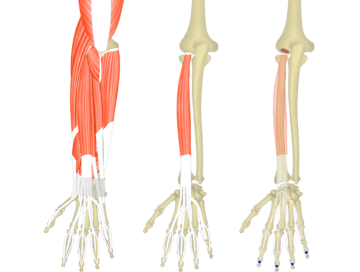Forearm Muscles
The superficial layer consists of the:
- flexor carpi ulnaris
- palmaris longus
- flexor carpi radialis
- pronator teres
The deep layer includes the:
- pronator quadratus
- flexor digitorum superficialis
- flexor digitorum profundus
- flexor pollicis longus
The superficial layer is composed of the:
- brachioradialis
- extensor carpi radialis longus
- extensor carpi radialis brevis
- extensor digitorum
- extensor digiti minimi
- extensor carpi ulnaris
- anconeus
The deep layer includes the:
- supinator
- abductor pollicis longus
- extensor pollicis brevis
- extensor pollicis longus
- extensor indicis
The brachioradialis is a muscle located in the forearm. It runs along the radius bone and is responsible for flexing the forearm at the elbow joint. The brachioradialis muscle is involved in various movements, such as bending the elbow to lift objects or perform actions like hammering or turning a doorknob.
Anconeus Muscle

The anconeus is a small muscle located in the back of the elbow joint. It assists in extending the forearm at the elbow and is involved in movements that straighten the arm.
The flexor carpi ulnaris is a muscle located in the forearm. It runs along the ulna bone and is responsible for flexing the wrist and adducting the hand, which means moving the hand toward the ulnar (pinky finger) side of the forearm.
The palmaris longus is a muscle located in the forearm. It runs along the inside of the arm and is responsible for flexing the wrist. The palmaris longus muscle is not present in everyone, and its absence does not significantly affect hand function.
The flexor carpi radialis is a muscle located in the forearm. It runs along the radius bone and is responsible for flexing the wrist and abducting the hand, which means moving the hand toward the radial (thumb) side of the forearm.
The pronator teres is a muscle located in the forearm. It runs along the inner side of the forearm and is responsible for pronation of the forearm, which means turning the palm downward or backward.
The flexor digitorum superficialis is a muscle located in the forearm. It runs along the inner side of the forearm and is responsible for flexing the fingers at the metacarpophalangeal and proximal interphalangeal joints.
The brachialis is a muscle located in the upper arm, underneath the biceps brachii. It plays a key role in elbow flexion, allowing you to bend your arm. The brachialis muscle is important for various movements that involve bending the elbow and is particularly active during exercises like curls and lifting objects.

The extensor carpi radialis longus is a muscle located in the forearm. It runs along the outer side of the forearm and is responsible for extending the wrist and abducting the hand, which means moving the hand towards the radial (thumb) side of the forearm.
Extensor Carpi Radialis Brevis

The extensor carpi radialis brevis is a muscle located in the forearm. It runs along the outer side of the forearm and is responsible for extending the wrist and abducting the hand, which means moving the hand towards the radial (thumb) side of the forearm.
Extensor Digitorum Muscle

The extensor digitorum is a muscle located in the forearm. It runs along the outer side of the forearm and is responsible for extending (straightening) the fingers at the metacarpophalangeal and proximal interphalangeal joints.
Extensor Carpi Ulnaris

The extensor carpi ulnaris is a muscle located in the forearm. It runs along the ulnar (pinky finger) side of the forearm and is responsible for extending the wrist and adducting the hand, which means moving the hand towards the ulnar side of the forearm.








